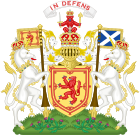Royal Mines Act 1424 facts for kids
| Act of Parliament | |

|
|
| Long title | Of mynis of golde and silver. |
|---|---|
| Citation | 1425 c. 13 |
|
Status: Current legislation
|
|
| Text of the Royal Mines Act 1424 as in force today (including any amendments) within the United Kingdom, from legislation.gov.uk | |
The Royal Mines Act 1424 was an important law made by the Parliament of Scotland. It said that any gold or silver mines found in Scotland would belong to the king. This was true if the mine's ore (the rock containing the metal) had enough valuable metal in it.
This law meant that these mines became inter regalia under Scots law. This is a fancy way of saying they were special property belonging only to the king. Even lead mines were included if their ore produced enough silver.
This act was later changed by the Mines and Metals Act 1592. The 1592 act took the mines away from the king's direct ownership. However, it still kept them as "inter regalia," meaning they were still seen as special royal property.
What Did the Royal Mines Act Say?
The original law was written in old Scottish language. Here's what it said:
Item gif ony myne of golde or siluer be fundyn in ony lordis landis of the realme and it may be prowyt that three halfpennys of siluer may be fynit owt of the punde of leide The lordis of parliament consentis that sik myne be the kingis as is vsuale in vthir realmys
In simpler, modern English, it means:
Item, if any gold and silver mines are found on any lord's land in the country, and it can be proven that three halfpennies worth of silver can be taken from a pound of lead, the lords of the parliament agree that such mines will belong to the king, as is the custom in other countries.
When and Where Was the Act Passed?
This law was passed by the Parliament of Scotland on May 26, 1424. The meeting took place in Perth, Scotland. King James I was the ruler of Scotland at that time. The law was officially called "Of mynis of golde and silver."
See also

